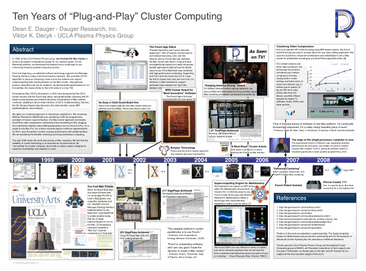
look inside!
For more about Apple's 1998 publication on our clustering approach:
  
|
|
Abstract:
In 1998, at the UCLA Plasma Physics group, we invented the Mac cluster
to achieve accessible computational power for our research goals. On the
Macintosh platform, we developed the earliest tools to build easy-to-use
numerically-intensive parallel computing clusters.
From the beginning, our patented software technology supports the
Message-Passing Interface, today a
dominant industry standard. We used
Mac OS 8's AppleTalk to discover computing nodes across the network and
support supercomputing-style communications on the Mac cluster. Using
plasma physics calculations we use for research, we demonstrated
performance on our 8-node Mac G3 cluster similar to that of 8 nodes of a
Cray T3E.
Prompted by Mac OS X's introduction, in 2001 we introduced the first OS
X cluster solution with the Pooch App debut, reincarnating Mac
clustering with IP-based communication and network discovery.
Development of Mac clusters continues, adapting to all six major
versions of OS X, multiprocessing, Xserves, the G5, Bonjour-based node
discovery, the Intel transition, seven MPI implementations, and
multicore.
We apply our clustering approach to mainstream applications. We
accelerate Wolfram Research's Mathematica by combining it with the
programming paradigm of today's supercomputers. Our Mac cluster approach
accelerates QuickTime video compression, particularly frame-reordering
H.264, plugging into mainstream desktop video-editing applications such
as Final Cut Pro. On a single 8-core Mac Pro,
our solution exceeds
Apple's multicore implementation by 300%, plus the ability to further
increase performance with additional Macs. We are excited by the
benefits clustering can bring mainstream computing.
The year 2008 marks the tenth anniversary of Mac clustering. We find
that the reliability of cluster technology is as important as its
performance. By "reinventing" the cluster computer, we provide a unique
solution designed to maximize accessibility and usability for users.
|








